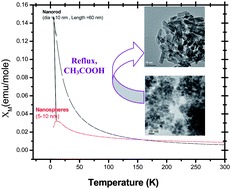Stabilization of Mn(iv) in nanostructured zinc manganese oxide and their facile transformation from nanospheres to nanorods†
Abstract
Nanostructured ternary manganese(IV) oxides are of importance as

* Corresponding authors
a
Department of Chemistry, Indian Institute of Technology, Hauz Khas, New Delhi, India
E-mail:
ashok@chemistry.iitd.ernet.in
Fax: +91-11-26854715
Tel: +91-11-26591511
b Department of Chemistry and Biochemistry, Rowan University, Glasboro, NJ, USA
c Department of Physics, Rowan University, Glasboro, NJ, USA
d Physics of Energy Harvesting, National Physical Laboratory (CSIR), New Delhi, India
Nanostructured ternary manganese(IV) oxides are of importance as

 Please wait while we load your content...
Something went wrong. Try again?
Please wait while we load your content...
Something went wrong. Try again?
Menaka, S. L. Samal, K. V. Ramanujachary, S. E. Lofland, Govind and A. K. Ganguli, J. Mater. Chem., 2011, 21, 8566 DOI: 10.1039/C1JM10425J
To request permission to reproduce material from this article, please go to the Copyright Clearance Center request page.
If you are an author contributing to an RSC publication, you do not need to request permission provided correct acknowledgement is given.
If you are the author of this article, you do not need to request permission to reproduce figures and diagrams provided correct acknowledgement is given. If you want to reproduce the whole article in a third-party publication (excluding your thesis/dissertation for which permission is not required) please go to the Copyright Clearance Center request page.
Read more about how to correctly acknowledge RSC content.
 Fetching data from CrossRef.
Fetching data from CrossRef.
This may take some time to load.
Loading related content
